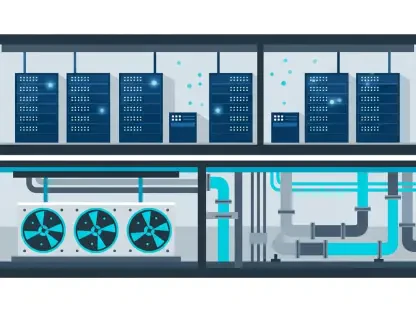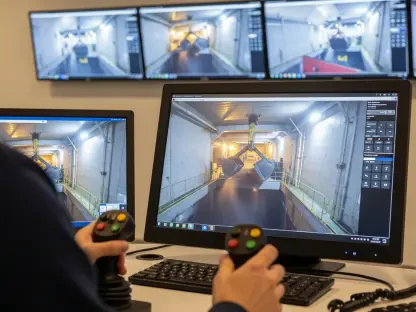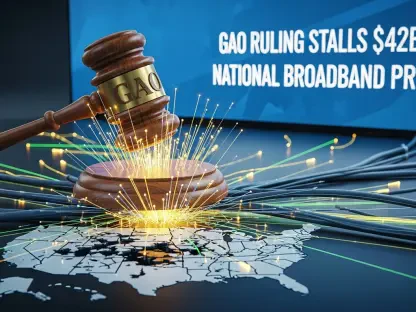In the heart of Minnesota, a silent crisis unfolds as thousands of residents grapple with the absence of reliable internet, a fundamental need in today’s digital age that impacts everything from education to economic opportunity. This gap, widely known as the digital divide, creates an invisible barrier, separating those with access to high-speed broadband from those stuck in a technological void. Rural families watch as their children struggle with online learning, while small businesses falter without the tools to compete in a connected world. Federal promises of universal connectivity have often crumbled under poor execution, leaving communities frustrated and disconnected. Yet, amidst this challenge, a powerful movement is rising from within the state. Minnesota’s local leaders and residents are refusing to wait for external solutions, instead forging their own paths to bridge this divide. Their efforts hint at a transformative possibility: could community-driven broadband be the key to ensuring no one is left behind in the digital era?
Federal Programs: A Legacy of Disappointment
Unfulfilled Commitments to Connectivity
Federal broadband initiatives, designed to close the digital gap, have repeatedly fallen short in Minnesota, leaving countless communities stranded without the promised infrastructure. The Rural Digital Opportunity Fund (RDOF), with its ambitious goal of connecting rural America, allocated over $400 million to the state, yet a staggering 80% of projects defaulted, failing to serve over 142,000 designated locations. This collapse represents more than just wasted funds; it signifies broken trust for families and businesses relying on reliable internet to thrive. Rural schools, unable to support online learning, and farmers missing out on precision agriculture tools are among the hardest hit. The federal approach often prioritizes quick fixes over sustainable solutions, ignoring the unique needs of Minnesota’s diverse landscapes. This persistent failure has fueled growing skepticism about centralized efforts, pushing local leaders to seek alternatives that deliver real results.
Beyond the defaults, the Broadband Equity, Access, and Deployment (BEAD) program, backed by a $42.5 billion national budget, has also stumbled in its mission to provide equitable access. Initially heralded for its focus on fiber-optic technology, a shift toward technology neutrality has favored cheaper options like satellite and fixed wireless, which fall short of long-term performance needs. In Minnesota, only 58% of BEAD-eligible locations are slated for fiber, while the rest are assigned less reliable alternatives. This policy pivot undermines the goal of future-proof connectivity, leaving many residents with subpar service that cannot support modern demands like telehealth or remote work. The frustration is compounded by the knowledge that these federal missteps are not mere oversights but systemic flaws in planning and execution, deepening the digital divide rather than closing it.
Wasted Resources and Lost Potential
Compounding the issue of failed projects is the federal decision to reclaim unspent funds rather than redirect them to critical complementary programs in Minnesota. Instead of investing in workforce development to train technicians or funding digital literacy initiatives to help residents navigate online tools, leftover BEAD allocations are pulled back, squandering opportunities for holistic progress. Many Minnesotans, especially in underserved areas, lack not only physical access to broadband but also the skills to leverage it effectively for education or job searches. This shortsighted policy ignores the reality that connectivity is only half the battle; without education and support, the benefits of internet access remain out of reach for large segments of the population. The impact is a vicious cycle where communities remain trapped in digital isolation, unable to break free due to federal priorities that overlook these essential needs.
Moreover, the misallocation of resources highlights a broader disconnect between federal policymakers and local realities, a gap that hinders progress in communities desperate for support. Funds that could have built lasting infrastructure or supported community-led initiatives are instead lost to bureaucratic inefficiencies. In rural Minnesota, where every dollar counts, this loss stings particularly hard as small towns watch potential growth slip away. Businesses that might have relocated to fiber-connected areas are deterred, and students fall further behind without access to online resources. The absence of strategic reinvestment reveals a lack of commitment to addressing the root causes of the digital divide, leaving Minnesota to grapple with the consequences of federal inaction while searching for homegrown solutions to fill the void.
Community Broadband: A Beacon of Hope
Pioneering Local Networks
In stark contrast to federal shortcomings, Minnesota communities are taking connectivity into their own hands with remarkable results that showcase the power of local innovation. Willmar’s $24.5 million open-access fiber project stands as a testament to what can be achieved when municipalities prioritize their residents’ needs, fostering competition among providers and ensuring reliable service for schools and businesses. Similarly, Southwest Broadband, a cooperative spanning nine small towns, has become a lifeline for rural areas, supporting vital sectors like education, agriculture, and telehealth. These initiatives are not mere stopgaps but strategic investments tailored to the unique challenges of each community. By focusing on fiber technology, they deliver high-speed internet capable of meeting modern demands, proving that local control can outpace federal efforts in both efficiency and impact.
Another inspiring example lies in the collaborative spirit of these projects, which often unite diverse stakeholders under a shared goal of connectivity. In places like Willmar, city officials, local businesses, and residents have worked together to fund and design networks that directly address gaps left by private providers. This collective approach ensures that the infrastructure serves not just the profitable urban fringes but also the remote corners often ignored by larger corporations. The success of these efforts sends a clear message: when federal and private sectors falter, Minnesota’s communities possess the resilience and ingenuity to build their own digital bridges. These stories of self-reliance are sparking interest across the state, encouraging others to consider similar paths toward closing the digital divide.
Blueprints for Statewide Progress
The triumphs of local broadband in areas like Dakota County and Scott County offer scalable models that could transform connectivity across Minnesota if adopted more widely. Dakota County’s countywide fiber backbone connects public institutions, ensuring that libraries, schools, and government offices operate on a robust network, while Scott County extends its infrastructure to underserved neighborhoods, tackling equity head-on. These projects demonstrate that community-owned networks can address both rural and suburban challenges, providing a framework for replication in diverse settings. By prioritizing fiber over less dependable technologies, these counties lay the groundwork for long-term growth, ensuring that their residents are not just connected today but prepared for tomorrow’s digital demands.
Scaling these successes requires strategic planning and investment, but the potential rewards are immense for Minnesota’s future. State-level support, through grants or policy incentives, could accelerate the spread of community broadband, turning isolated victories into a cohesive network that spans the region. Lessons from Dakota and Scott Counties reveal the importance of local governance in customizing solutions—whether it’s funding models or partnership structures—that align with specific community needs. This adaptability stands in sharp contrast to the one-size-fits-all federal programs that often fail to account for regional differences. As more areas witness the tangible benefits of these initiatives, momentum builds for a statewide movement that could finally ensure no Minnesotan is left offline due to geography or economic status.
Transformative Power of Local Connectivity
Revitalizing Communities Economically and Socially
Community-owned broadband in Minnesota transcends mere internet access, acting as a powerful engine for economic and social revitalization that reshapes entire regions. Economically, fiber networks attract businesses seeking reliable connectivity for remote work and digital operations, creating jobs and stimulating local markets. In rural areas, this influx can mean the difference between stagnation and growth, as entrepreneurs find new opportunities to compete on a global stage. Beyond commerce, these networks bolster telehealth services, allowing residents to access medical care without long journeys to urban centers. The ripple effect is a strengthened local economy where dollars stay within the community, fostering a cycle of prosperity that federal programs have failed to ignite.
Socially, the impact is equally profound as broadband helps stem the tide of population decline in rural Minnesota. By offering digital opportunities comparable to those in cities, these networks encourage young families to stay or relocate to smaller towns, preserving community vitality. Schools benefit immensely, with students gaining equal access to online learning platforms, closing educational disparities that have long plagued remote areas. Additionally, the sense of connection—both literal and figurative—enhances civic engagement, as residents participate in virtual town halls or access government services online. This transformation positions broadband as a cornerstone of social equity, ensuring that geographic isolation no longer equates to digital exclusion, and reinforcing the fabric of Minnesota’s diverse communities.
Sustainable Financial and Technological Growth
Financially, owning broadband infrastructure offers Minnesota communities a sustainable path forward by keeping resources local and generating new revenue streams. Unlike federal funds that vanish or private providers that siphon profits elsewhere, community networks reinvest earnings into local priorities, whether that’s maintaining the infrastructure or funding public services. Leasing excess capacity to private entities or supporting smart-city applications—such as traffic management systems—creates additional income that benefits taxpayers directly. This self-sustaining model reduces dependency on external aid, providing a buffer against the uncertainty of federal budgets and ensuring long-term affordability for residents who might otherwise struggle with high internet costs.
Technologically, fiber-based community networks position Minnesota at the forefront of innovation, ready to embrace future advancements that demand high bandwidth and low latency. Applications like artificial intelligence, which require robust connectivity for real-time data processing, become feasible in even the most remote areas, opening doors to cutting-edge industries. Public safety also sees gains through fiber-enabled sensing technologies that monitor infrastructure or detect emergencies swiftly. This forward-thinking approach contrasts sharply with federal reliance on outdated solutions like satellite, which cannot support such progress. By investing in fiber now, Minnesota communities lay a foundation for technological resilience, ensuring they are not just catching up but leading the way in a rapidly evolving digital landscape.
Seizing the Moment for a Connected Future
The Imperative of Immediate Action
Time is of the essence for Minnesota as the digital divide continues to widen with each passing day that communities remain unconnected, and federal programs have shown little promise of delivering reliable solutions in the near future. Delays and policy shifts stall progress at every turn. Students unable to access online resources fall further behind their peers, while workers miss out on remote job opportunities that could transform their livelihoods. The cost of inaction is measured not just in lost economic potential but in the erosion of equity across the state. This critical juncture demands swift, decisive steps to prioritize broadband as an essential utility, ensuring that no resident is denied the opportunities that come with being online.
The urgency is heightened by the growing reliance on digital tools in every facet of life, from healthcare to civic participation. Minnesota’s rural areas, often the hardest hit by connectivity gaps, face a stark reality where lack of internet access equates to exclusion from modern society. Waiting for federal intervention risks further entrenching these disparities, as other regions with better access surge ahead. Local leaders must recognize that the window to act is narrowing, with each missed chance compounding the challenges for future generations. A proactive stance now—through funding, policy support, and community engagement—can turn the tide, making broadband a reality for all and preventing the digital divide from becoming an insurmountable chasm.
Harnessing a Tradition of Resilience
Minnesota’s storied tradition of self-reliance offers a solid foundation for tackling the broadband crisis with community-driven solutions. Historically, the state’s towns and counties have banded together to solve pressing issues, from infrastructure to public services, often outpacing external aid with their ingenuity. This spirit is evident in the success of local broadband networks, where municipalities have built systems that directly address their unique challenges. Drawing on this legacy, the state can rally around a shared commitment to connectivity, empowering more regions to develop their own networks without awaiting federal approval or funding that may never materialize.
This historical resilience also serves as a unifying force, inspiring collaboration across diverse communities to achieve a common goal. Statewide initiatives could harness this momentum by providing resources—such as technical expertise or seed funding—to help smaller towns replicate the successes of places like Willmar or Dakota County. By framing broadband as a collective challenge, Minnesota can foster a sense of shared responsibility, encouraging partnerships between local governments, businesses, and residents. This approach not only builds infrastructure but also strengthens community bonds, ensuring that the push for connectivity is as much about people as it is about technology. The state’s past proves that when faced with adversity, Minnesotans rise to the occasion, and the digital divide should be no different.
Pursuing Fairness Through Access
At its core, bridging the digital divide in Minnesota is a matter of fairness, ensuring that every resident, regardless of location or income, can participate in the digital world. High-speed internet is no longer a mere convenience but a gateway to education, healthcare, and economic stability—essentials that should be available to all. Without it, rural students face unequal learning opportunities, and families struggle to access telemedicine during critical times. Framing broadband as a fundamental right shifts the conversation from technical logistics to moral necessity, compelling action to level the playing field across the state.
This pursuit of equity demands a focus on the most vulnerable populations, often overlooked by profit-driven private providers, and community broadband excels in reaching these groups by tailoring solutions to include low-income households and remote areas that larger corporations deem unprofitable. State policies should prioritize these efforts, ensuring that funding and support target the deepest pockets of digital exclusion. By doing so, Minnesota can address systemic inequalities that extend beyond connectivity, fostering an environment where every individual has the tools to succeed. This commitment to fairness transforms broadband from a utility into a vehicle for social justice, aligning with the state’s values of inclusion and opportunity.
Setting a Precedent for the Nation
Minnesota stands poised to not only resolve its own connectivity challenges but also to inspire a national movement through its embrace of local broadband. By championing community-owned networks, the state can demonstrate a viable alternative to federal dependency, showing other regions how to take charge of their digital futures. The successes in places like Southwest Minnesota and Scott County serve as powerful case studies, illustrating that localized solutions can outperform centralized efforts in both efficiency and impact. This leadership could spark a wave of similar initiatives across the country, redefining how the digital divide is addressed.
Becoming a national model requires amplifying these stories of triumph, sharing best practices, and advocating for policies that support community broadband at every level. Minnesota’s journey could influence federal lawmakers to rethink their approach, prioritizing local control and fiber technology over temporary fixes. Additionally, partnerships with national advocacy groups can help broadcast the state’s achievements, encouraging other states to follow suit. This vision of leadership is not just aspirational but achievable, rooted in the tangible progress already made. By continuing to innovate and invest in community networks, Minnesota can pave the way for a connected nation, proving that the path to digital equity begins at home.









